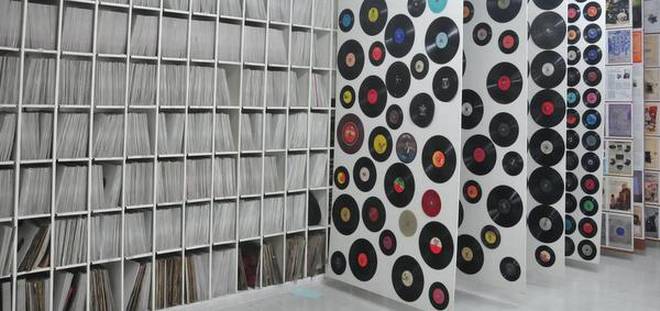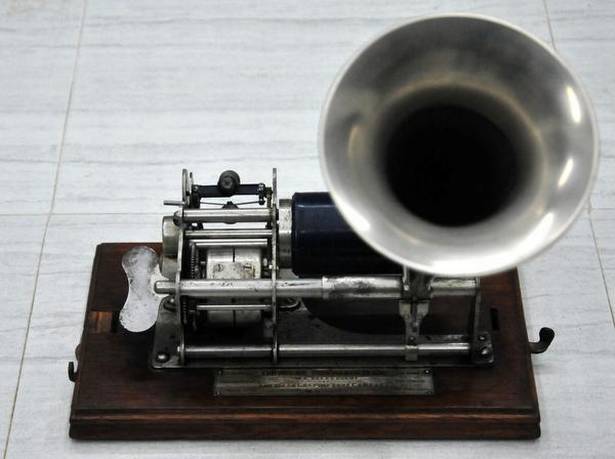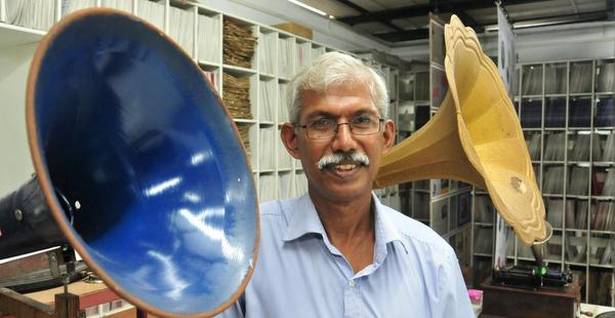Inside a private museum of old gramophone records and players tucked away in Kerala's Kottayam district.

With great care Sunny Mathew extricates a shellac record from a faded sleeve, wipes it gently and almost reverentially places it on the turntable of a vintage gramophone. Selecting a needle from a dusty box, he fixes it on the head of the player and gently drops it on the record. Sunny’s face breaks into a wide smile as the hushed whirring of the turntable gives way to a scratchy, high-pitched song from another era.
“That is 14-year-old Soshi Mukhi, a nautch girl from Classic Theatre, creating history in a studio in Calcutta on November 8, 1902, for Frederick Gaisberg of The Gramophone Company. The first recorded music in India was this teenager’s because none of the reputed musicians in Calcutta agreed to have their voices recorded — they considered it beneath them. But when they heard Soshi’s recording, they quickly changed their minds and Gauhar Jaan consented to sing,” says Sunny.
As the record winds to a stop, Sunny takes it out, places it back in its sleeve and keeps it on a shelf next to several such records. Next comes a quaint morality play set in a classroom in rural Kerala. Sunny chooses records, one after the other, to showcase the range and diversity of his collection. Drama and film songs in Tamil, gospel music in Malayalam, snatches of Carnatic songs sung by legends, speeches of great leaders, Tagore reciting the national anthem, many versions of Vande Mataram...
Mint records
In lush and green Pala, in the heart of plantation country in Kerala’s Kottayam district, is Discs & Machines — Sunny’s Gramophone Museum and Records Archive, a remarkable collection of vintage records housed in a double-storeyed, air-conditioned building with an atrium. It is a treasure trove with more than a lakh gramophone discs, of which around 75% are 78 rpm shellac records, cylinder records and wire records; there are also more than 260 gramophones.

The gramophones include external floral horn models, table models, cabinet models, Decca models (suitcase), pocket types, children’s toy gramophones, phonographs for playing cylinder records, electrical players and wire recorders. The earliest in his collection dates to 1897.
Floor-to-ceiling metal shelves cover the first floor, stacked with records of different kinds, neatly categorised and arranged. Sunny has also documented the history of capturing and preserving sound and its many milestones in India on long flex boards that are hung on racks, all of them designed by Sunny himself.
Photographs of inventors, scientists, industrialists and musicians, people who enriched the recording scene, have pride of place in the museum. Even Francis Barraud’s painting of Nipper the dog listening to a record, which later went on to become the logo of record label HMV, finds a place. On the second floor are gramophones as well as musical instruments, household implements, cameras and sewing machines.
Sunny’s fascination for records began in childhood. “My father had a small collection: Tamil, Hindi and Malayalam songs, Biblical plays and dramas that we used to listen to on HMV’s Model 102 suitcase gramophone. Those records were part of my growing up. Years later, serendipity took me to a flea market near Madurai where I chanced upon a floral external horn-type gramophone and some shellac records. I bought them for a song, cleaned them and found that they were in good condition. I also took the records from my ancestral home and that’s how my collection was born,” he says.
Gradually, his collection grew and he began to haunt flea markets across Kerala and in Bengaluru and Chennai. “I found old Tamil and Kannada songs and drama sets in second-hand shops in Madurai. Some of my oldest records — musical dramas such as Sita Swayamvaram, Prahalada, Kovalan and Shankuntala — are from there,” he says. The oldest is an 1898 record of an English song, while a shellac record from 1911 is perhaps the oldest Malayalam one.
“Not even the descendants of these old-time musicians took the trouble to preserve their records. Some of them heard about my museum and came to Pala to find out if I had recordings. A couple of years ago, an elderly gentleman visited and became emotional when he heard a record cut by his mother,” recalls Sunny.
Scratches and termites
He is always on the lookout. Whenever he hears of an old house being demolished, he visits and invariably returns with rich pickings. “I have found vintage records in attics, cellars, discarded suitcases and cardboard boxes. Recently, I got a precious collection of recordings, old cameras and recorders from an industrialist’s home in Thiruvananthapuram.

He learnt through trial and error to clean dusty records and restore, even if partially, those with scratches and termites. Becoming a member of Mumbai-based The Society of Indian Record Collectors helped him understand the value of his collection. The society’s founder put him in touch with other collectors. “Till then, collecting records had been just a passion. But then I realised their archival value. I got in touch with Vienna-based Gesellschaft für Historische Tonträger and that is how I became a researcher,” he says.
In 2013, after he retired from the Kerala Forest Development Corporation, he decided to build a museum next to his house. In 2015, he sunk his pension money into the building and the museum was inaugurated on January 25. Every anniversary of the museum is observed with a seminar on recording that is attended by well-known names from India and abroad. Sunny has been presenting papers in national and international fora.
To share the enviable collection with enthusiasts, he has been uploading some of the records on YouTube (sunny78rpmmusic) and also digitising a part of his collection. “It is a painstaking task but I am not complaining. These cartons are all filled with spools, tapes and records that I have to sort out,” he says, pointing to half-opened boxes spilling out everywhere in his house.
“I am now busy with the digitisation of early period recordings made in India from 1902 to 1927 for British Library’s Endangered Archives Programme,” he says. “My wife and son assist me in this mega project to digitise 3,000 recordings. Once the work is over, the recordings will be uploaded by British Library and made available to the public.”
Courtesy of The Hindu



